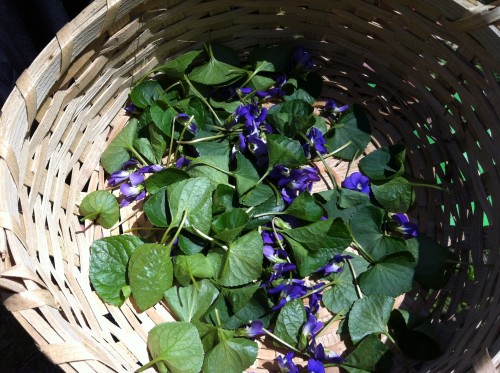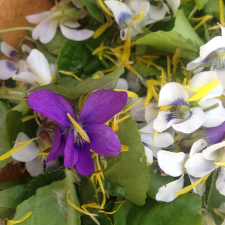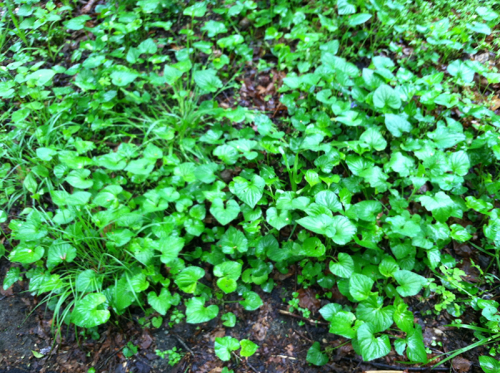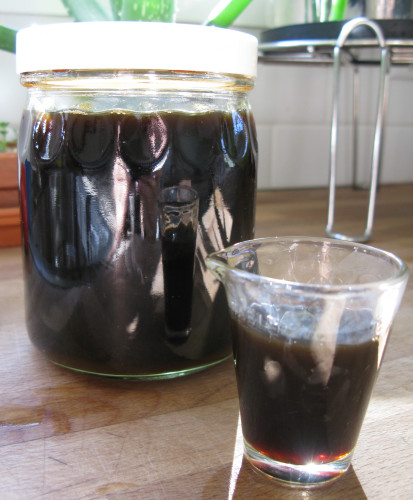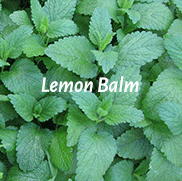Viola – Viola sororia
Violets are an excellent ground cover species with edible leaves and flowers. There are both running and clumping types. I prefer the clumping types; but all are fun to have in the garden; they kind of march around. They are semi-evergreen with dense, tidy foliage. The sweet violet (V. odorata) has the best tasting leaves, but all the types have wonderful flowers for salads, candying or in drinks. By weight, violet leaves have almost as much Vitamin A as carrots. Medicinally, Violet clears heat, reduces swelling and deters infection. It is used as a tea, fresh in salad, as a compress, tinctured, or as a gargle.
Family: Violaceae, Violet Family.
AKA: Viola odorata, Violet, Viola, heartsease, sweet violet, dooryard violet
Parts used: leaf, flower, and root.
Uses: To treat acne, abscesses, cysts, mastitis, carbuncles and boils; for asthma, bronchitis, pleurisy, tuberculosis, colds, fever, laryngitis, sore throat, catarrh, and for skin issues like eczema and psoriasis. Violet excels at clearing any lymphatic congestion.
Infusion: 1 cup cold water over ½ teaspoonful of flower and leaf, bring to boil and leave to infuse for 20 minutes, drink 3x/day. Violet leaf and flower are safe and gentle.
Actions: Anti-fungal, alterative, anti-inflammatory, antiseptic, antiscorbutic, astringent, cathartic (root), demulcent, diaphoretic, diuretic, emetic (root), emollient, expectorant, febrifuge, laxative (mild), nutritive, restorative, purgative (root), vulnerary, lymph-moving.
Constituents: The leaf and flower have beta-carotene, vitamin C, methyl salicylate, saponin, alkaloids such as violene, odoratine, flavonoids such as rutin, mucilage, volatile oil, essential oil. The root is highest in the alkaloid violene.
Tincture:
Harvest: Spring is the best time to harvest the leaf and flower, root can be harvested in spring or fall. A fresh salad of the leaf and flower with dandelion and other spring greens is a favorite treat.
Taste: Slightly mucilaginous, cucumber-y, clean. Flowers can be slightly bitter but with a floral tang.
Flower Essence: Helps those who feel lonely despite being surrounded by others. Helps interaction with protecting individual. Increases openness, faith, warmth and strength.
Combines: In the garden, I love violets as a groundcover that performs well on the border with taller but later-to-arrive perennials. As medicine, I find Violet combines well with other spring tonic herbs like cleavers and dandelion. And in a salad, I love them with dandelion flower petals and leaves and with sorrel leaves.
Plant ID: A prettily veined cordate leaf with basal arrangement, 5-part flower borne on erect stem from center of basal leaf cluster. Often grows in colonies or groups.
Historical: Violets were regarded as a symbol of innocence and modesty. Romans planted violets upon graves of children. Napoleon’s wife Josephine loved the scent of violets; he carried a locket with violets and her hair. In the 19th century, violets were in fashion and they were farmed in large tracts. Violet fragrance is used in many products: perfumes, toiletries, syrups, jellies, pastilles, liqueurs and chocolates.

